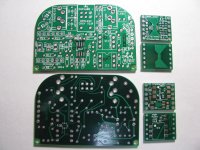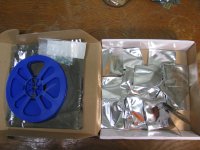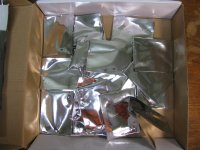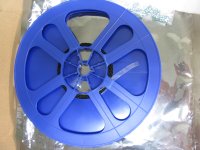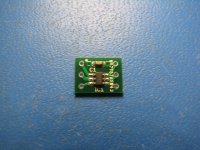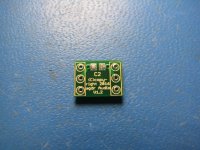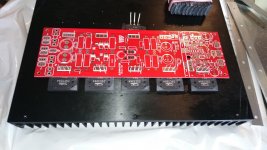I really appreciate the quality of their work, it's very very good. They are also remarkably cheap for a small, independent outfit.
Quick Circuits | PCB Manufacture & Assembly
Thanks. Of course "remarkably cheap" is a relative term. Most fabrication houses do get pretty reasonable when you have larger quantities. The reason for the interest in PCBWAY and similar China based companies is that they are beyond remarkably cheap for low quantities. With their usual discounts applied, I'll typically pay just over $20 USD, for 20 small (maybe 2 inch x 1-1/2 inch) two layer boards, complete with oddball cutouts. These are blank boards and I'll have to populate them myself. But this is usually for a prototype anyway. In fact, I'd normally not order more than a handful of boards if not for the fact that most of that $20 will be set-up charge, making the price ddifference between 5, 10, or 20 boards hard to turn down.
For small batch prototype blanks like that, I wouldn't mind paying a "LITTLE" more, especially for difficult cases where easy communication is essential. But what do you think "Quick Circuits" would charge for that same size run of 20 boards?
I don't know, Peter.
I remember getting a quote for a smaller quantity of boards and it was higher - closer to $10-15/board.
In terms of pure cost alone, you can't beat the China labs. I've used them with a good result. However, I'm prepared to pay a little more, perhaps twice as much (on a small run, we're talking $100s, not $1000s), especially if it gives me a quality, precise final product and any queries are immediately handled by people who are expert at their job and speak the same language.
As a small, local firm, I was expecting pricing to be multiples of 10 rather than 1.5 - 2, that's all
In my case, I also win from a postage perspective. To get anything quick from China, I have to use the courier they use, in this case DHL. My $20 set of 10x PCBs end up costing me around $80 by the time I've added the $30 delivery / paypal. Then customs charge me another $20 for importing. And it all adds a few days.
With Quick Circuits, they produced my PCBs with a 5 day lead time. I went round to pick up when done. I paid by bank transfer. So whilst the hardware cost might be more, once I factored in all the other hidden extra costs imposed when using people like PCB Way / DHL, then the price difference is somewhat eroded.
Of course, if you're based in the US, then your mileage may vary, expecially if you don't already get stung by DHL / customs.
I remember getting a quote for a smaller quantity of boards and it was higher - closer to $10-15/board.
In terms of pure cost alone, you can't beat the China labs. I've used them with a good result. However, I'm prepared to pay a little more, perhaps twice as much (on a small run, we're talking $100s, not $1000s), especially if it gives me a quality, precise final product and any queries are immediately handled by people who are expert at their job and speak the same language.
As a small, local firm, I was expecting pricing to be multiples of 10 rather than 1.5 - 2, that's all
In my case, I also win from a postage perspective. To get anything quick from China, I have to use the courier they use, in this case DHL. My $20 set of 10x PCBs end up costing me around $80 by the time I've added the $30 delivery / paypal. Then customs charge me another $20 for importing. And it all adds a few days.
With Quick Circuits, they produced my PCBs with a 5 day lead time. I went round to pick up when done. I paid by bank transfer. So whilst the hardware cost might be more, once I factored in all the other hidden extra costs imposed when using people like PCB Way / DHL, then the price difference is somewhat eroded.
Of course, if you're based in the US, then your mileage may vary, expecially if you don't already get stung by DHL / customs.
Combined shipping at pcbway
Here is another pcbway ordering trick I've run into. I had 3 different project boards to go out and asked if they have combined shipping for the DHL. Sure enough, if you submit them all at the same time, when they come back from the "review" phase it will show combined shipping.
I had 3 different project boards to go out and asked if they have combined shipping for the DHL. Sure enough, if you submit them all at the same time, when they come back from the "review" phase it will show combined shipping.
On the 3 boards below, 10 of the bigger 4-layer and 20 of each of the smaller 2-layer the DHL shipping would have been $25 each. By submitting them all at once it came back with just one $25 shipping for the whole bunch! Sure enough they all arrived today in the same box.
I'm taking advantage of that again an sent out 3 more yesterday. This had two 4-layers of 1o pieces each and 1 2-layer at 10 pieces. The individual DHL shipping showed $25 each on them. The combined shipping for the 3 projects together clocked in at $38. I guess $38 is their next-larger standard box size past the $25.
On the first combined order their "review" of the submitted boards didn't happen for about 40 minutes, so no troubles with getting all 3 submitted before the review. On the second batch though the review started just about 5 minutes after I submitted the 3rd project! I would guess that if they happen review them before all the projects are submitted that customer support could be emailed to make the combine ship number correct.
Here is another pcbway ordering trick I've run into.
On the 3 boards below, 10 of the bigger 4-layer and 20 of each of the smaller 2-layer the DHL shipping would have been $25 each. By submitting them all at once it came back with just one $25 shipping for the whole bunch! Sure enough they all arrived today in the same box.
I'm taking advantage of that again an sent out 3 more yesterday. This had two 4-layers of 1o pieces each and 1 2-layer at 10 pieces. The individual DHL shipping showed $25 each on them. The combined shipping for the 3 projects together clocked in at $38. I guess $38 is their next-larger standard box size past the $25.
On the first combined order their "review" of the submitted boards didn't happen for about 40 minutes, so no troubles with getting all 3 submitted before the review. On the second batch though the review started just about 5 minutes after I submitted the 3rd project! I would guess that if they happen review them before all the projects are submitted that customer support could be emailed to make the combine ship number correct.
Attachments
Last edited:
I tried something similar before but wasn't as successful and it annoyed me a bit.
20 boards of x dimensions and shipping is $25.
Then 10 design-A boards of x dimensions and 10 design-B boards of the same x dimensions came out at $38 or something similar. The physical and volumetric weight was exactly the same, yet the price increased quite a bit.
It just shows it's worth playing around a bit with the system to see if you can get it to work out better for you.
20 boards of x dimensions and shipping is $25.
Then 10 design-A boards of x dimensions and 10 design-B boards of the same x dimensions came out at $38 or something similar. The physical and volumetric weight was exactly the same, yet the price increased quite a bit.
It just shows it's worth playing around a bit with the system to see if you can get it to work out better for you.
Well here's my recent report. First of all you may recall I occasionally make boards that are just control panels... black solder mask, white silkscreen, and holes or rectangles cut. I recently had a board like this cut, plus another regular electrical board whose only unusual quality also included some rectangles cut out within the PC shape. All in all I was shocked they did what I asked as well as they did.
There was one mishap, and one thing that could have been better. For the mishap, I had ordered 2 boards and then submitted a third directly through email to my rep. She, unfortunately, did not pay attention to all the items in the txt file included in my ZIP, and got the board thickness wrong. However, there was no bantering. I mentioned the error, and they took responsibility and gave me full credit for the board.
The other thing that could have been better is one you might only run into if you are also fabricating what I'm calling "control panel" boards, and that is the silkscreen resolution. Its not bad on most of the text board labels, but I had imported a company logo into a font generator, since fonts are vector based and easily scaled. Well as it turns out, I had that control panel board done both by PCB Way, and simultaneously by another company (PCBMIL.COM) which was actually started by a former PCB WAY affiliate who "defected" and started his own firm. Looking at the two results side by side, that logo on the PCBWAY version was notably more blurry then the one PCBMIL did. This is not the kind of thing you can complain about. Its kind of the luck of the draw. But for something as visible as a control panel, I'm glad I had a choice.
Just to offer a mental image of what I'm talking about, this photo shows my control panel stacked with the electrical board that supports it. In this shot, the better (PCBMIL) control panel was used, and the electrical board was made by PCBWAY. One LED had not yet been mounted in the upper right, but you can see my little "Elf" logo in the lower left. On the PCBWAY version, that elf much less distinct.
http://elfintechnologies.com/pubImages/ControlStackPCBs.jpg
There was one mishap, and one thing that could have been better. For the mishap, I had ordered 2 boards and then submitted a third directly through email to my rep. She, unfortunately, did not pay attention to all the items in the txt file included in my ZIP, and got the board thickness wrong. However, there was no bantering. I mentioned the error, and they took responsibility and gave me full credit for the board.
The other thing that could have been better is one you might only run into if you are also fabricating what I'm calling "control panel" boards, and that is the silkscreen resolution. Its not bad on most of the text board labels, but I had imported a company logo into a font generator, since fonts are vector based and easily scaled. Well as it turns out, I had that control panel board done both by PCB Way, and simultaneously by another company (PCBMIL.COM) which was actually started by a former PCB WAY affiliate who "defected" and started his own firm. Looking at the two results side by side, that logo on the PCBWAY version was notably more blurry then the one PCBMIL did. This is not the kind of thing you can complain about. Its kind of the luck of the draw. But for something as visible as a control panel, I'm glad I had a choice.
Just to offer a mental image of what I'm talking about, this photo shows my control panel stacked with the electrical board that supports it. In this shot, the better (PCBMIL) control panel was used, and the electrical board was made by PCBWAY. One LED had not yet been mounted in the upper right, but you can see my little "Elf" logo in the lower left. On the PCBWAY version, that elf much less distinct.
http://elfintechnologies.com/pubImages/ControlStackPCBs.jpg
For me the first time I placed an order at PCBWAY.First I mailed them to ask if my gerbers were OK,they answered right away.Second I placed my order get a shipping date and they arrived on time as they had stated.Only I had to wait for DHL regarding customs fee.The boards look fanstastic.
Pcbway board assembly experience
I finally had an opportunity to try out pcbway's assembly service. I'm quite impressed!
I had been talking on and off with one of their customer service reps for a few months about potentially assembling this board. The chip involved, a TPS3701DDCT comparator, is a SOT-23-6 that has proved to be just too small to reliably hand solder, for me anyway. I wanted to get 50 assembled professionally. Having the board fabrication house do it seemed like it would skip a step. They can fabricate the board, assemble them, then ship off the assembled board. Everything went pretty smoothly with a few twists and turns along the way.
Pcbway's assembly quoter wants your Gerber files, a "centroid file", and a BOM. The centroid file tells the assembly machines where the center of each part is. If you are using Eagle it turns out that file is easy to generate. On your board layout view click on the "run ULP" button at the top and run the program "centroid - screaming circuits". The output file winds up in the same place as your generated gerbers. The BOM can just be a spreadsheet dumped as a comma separated list file (.csv). The format of the BOM isn't critical, just put headers on the columns to show what they are.
Pcbway can quote the assembly using your parts you mail in, their parts, or a combination of the two. In my case it turned out the TPS3701DDCT chip wasn't available in China yet, so I went with the third option. The board uses a 0603 sized 0.1uF 100V MLCC they sourced for $0.01 each - cheaper than I could buy them - then I mailed them the chips. First time I've bought a "mouse reel" from Mouser Electronics, their partial reel service, which is the blue reel in the photo below. Mouser charges a $7 fee to create the partial reel. Pcbway required sending in some overage, 80 chips to assemble 50 boards, but they returned the extras on the reel. Pcbway requested the chips be on a continuous strip, hence the partial reel.
Another thing I ran into was board size. Their minimum for machine assembly is 50 mm x 50 mm. This tiny adapter board is only 10.5 mm x 7.9 mm and they told me up front it would be hand-soldered. At first I balked at that, but given the trouble I was having soldering the tiny chip I figured they presumably do this all day long and have folks with maginifiers and steady hands. Sure enough, as the photos show the resulting solder job looks as good as a machine to me.
Sure enough, as the photos show the resulting solder job looks as good as a machine to me.
The boards can have lead-free finish at pcbway and they can assemble with lead-free solder. I never use lead-free solder myself, so this seemed like a good opportunity to get it done as lead-free and RoHS. I think it wound up being an extra $10 or so total for lead-free.
One small hiccup came in mailing the reel of chips. For some reason DHL out from the US is a lot more expensive than DHL to the US from China. I went with the post office here instead, which charges $13.50 to send a padded envelope overseas, then another $13.50 to have it sent "registered", which was supposed to provide tracking the whole way. The "registered" thing turned out to not really work. It did wind up going by air (postal clerk thought it went by ship) by being registered and arrived in Beijing in just 4 days. But there it sat for the next 4 weeks with the tracking saying "departed Beijing for destination". I assumed it was stuck in customs, but instead the postal folks over there simply had not let pcbway know the package was ready for pickup. So my advice here is use DHL, the extra cost and real end-to-end tracking is worth it. I believe DHL has in-house customs which speeds things up.
I assumed it was stuck in customs, but instead the postal folks over there simply had not let pcbway know the package was ready for pickup. So my advice here is use DHL, the extra cost and real end-to-end tracking is worth it. I believe DHL has in-house customs which speeds things up.
Once pcbway got the chips they immediately started the assembly. They had already fabricated the bare boards weeks before. They sent me a photo of one assembled board to get an OK, then they had the rest soldered up and in the mail by the end of the next day. I was impressed that they bagged each one in a separate little anti-stat bag, in the photos below. The whole thing was then put in a large anti-stat bag. I only had the two surface mount parts assembled. There are two rows of connection pins I'm going to solder myself. Finally got some no-clean lead-free solder. Leaving the through-hole connection pins out of the assembly reduced the cost a bit and made the boards small for mailing.
Leaving the through-hole connection pins out of the assembly reduced the cost a bit and made the boards small for mailing.
All in all I'm very happy with their assembly work and would recommend it. They communicated well (email) through the whole process.
I finally had an opportunity to try out pcbway's assembly service. I'm quite impressed!
I had been talking on and off with one of their customer service reps for a few months about potentially assembling this board. The chip involved, a TPS3701DDCT comparator, is a SOT-23-6 that has proved to be just too small to reliably hand solder, for me anyway. I wanted to get 50 assembled professionally. Having the board fabrication house do it seemed like it would skip a step. They can fabricate the board, assemble them, then ship off the assembled board. Everything went pretty smoothly with a few twists and turns along the way.
Pcbway's assembly quoter wants your Gerber files, a "centroid file", and a BOM. The centroid file tells the assembly machines where the center of each part is. If you are using Eagle it turns out that file is easy to generate. On your board layout view click on the "run ULP" button at the top and run the program "centroid - screaming circuits". The output file winds up in the same place as your generated gerbers. The BOM can just be a spreadsheet dumped as a comma separated list file (.csv). The format of the BOM isn't critical, just put headers on the columns to show what they are.
Pcbway can quote the assembly using your parts you mail in, their parts, or a combination of the two. In my case it turned out the TPS3701DDCT chip wasn't available in China yet, so I went with the third option. The board uses a 0603 sized 0.1uF 100V MLCC they sourced for $0.01 each - cheaper than I could buy them - then I mailed them the chips. First time I've bought a "mouse reel" from Mouser Electronics, their partial reel service, which is the blue reel in the photo below. Mouser charges a $7 fee to create the partial reel. Pcbway required sending in some overage, 80 chips to assemble 50 boards, but they returned the extras on the reel. Pcbway requested the chips be on a continuous strip, hence the partial reel.
Another thing I ran into was board size. Their minimum for machine assembly is 50 mm x 50 mm. This tiny adapter board is only 10.5 mm x 7.9 mm and they told me up front it would be hand-soldered. At first I balked at that, but given the trouble I was having soldering the tiny chip I figured they presumably do this all day long and have folks with maginifiers and steady hands.
The boards can have lead-free finish at pcbway and they can assemble with lead-free solder. I never use lead-free solder myself, so this seemed like a good opportunity to get it done as lead-free and RoHS. I think it wound up being an extra $10 or so total for lead-free.
One small hiccup came in mailing the reel of chips. For some reason DHL out from the US is a lot more expensive than DHL to the US from China. I went with the post office here instead, which charges $13.50 to send a padded envelope overseas, then another $13.50 to have it sent "registered", which was supposed to provide tracking the whole way. The "registered" thing turned out to not really work. It did wind up going by air (postal clerk thought it went by ship) by being registered and arrived in Beijing in just 4 days. But there it sat for the next 4 weeks with the tracking saying "departed Beijing for destination".
Once pcbway got the chips they immediately started the assembly. They had already fabricated the bare boards weeks before. They sent me a photo of one assembled board to get an OK, then they had the rest soldered up and in the mail by the end of the next day. I was impressed that they bagged each one in a separate little anti-stat bag, in the photos below. The whole thing was then put in a large anti-stat bag. I only had the two surface mount parts assembled. There are two rows of connection pins I'm going to solder myself. Finally got some no-clean lead-free solder.
All in all I'm very happy with their assembly work and would recommend it. They communicated well (email) through the whole process.
Attachments
Last edited:
$210 for all the work at pcbway, which included fabricating the 50 lead-free bare boards, the 50 0603 capacitors, surface mount lead-free assembly/soldering, the paypal fee, and DHL shipping back to the US. The 50 chips at Mouser were $110 (I bought 80, but at their 50 piece price the 50 used come to $110), shipping and tax from Mouser was $16, the mouse reel fee was $7, then the USPS shipping for the chips was the $27.
So all total ($370 / 50 boards) = $7.40 a board.
What really made the decision for me was going through 3 chips every time I tried to solder a board myself. One or two would fly off the tweezers and wind up in the rug. I often had to re-position a chip so many times (to get the other 5 pads lined up with just one corner pad soldered) I started worrying about heat damage and tossed the chip in the trash. I've been soldering for 40+ years and almost never kill a chip with soldering heat anymore. Yet I managed to do it with two of these boards I assembled.
One or two would fly off the tweezers and wind up in the rug. I often had to re-position a chip so many times (to get the other 5 pads lined up with just one corner pad soldered) I started worrying about heat damage and tossed the chip in the trash. I've been soldering for 40+ years and almost never kill a chip with soldering heat anymore. Yet I managed to do it with two of these boards I assembled.
I did try quoting two US assembly outfits and the cost would have been something like 3x - 5x.
A higher quantity would have really lowered the price. I asked how much to assemble 100 rather than 50 and it was just incrementally more, something like $240 instead of $210 as I recall. A lot of the price is probably one-time setup. I just didn't know what I would do with that many boards!
So all total ($370 / 50 boards) = $7.40 a board.
What really made the decision for me was going through 3 chips every time I tried to solder a board myself.
I did try quoting two US assembly outfits and the cost would have been something like 3x - 5x.
A higher quantity would have really lowered the price. I asked how much to assemble 100 rather than 50 and it was just incrementally more, something like $240 instead of $210 as I recall. A lot of the price is probably one-time setup. I just didn't know what I would do with that many boards!
Last edited:
I recently put a pcb order into pcbway.
I sent off my files and they were approved.
The pcb is a little odd in that it has some none plated holes for TO3 transistors.
After a day I had a look through my files again in my gerber viewer.
I suddenly realised I had sent a blank drill file for the none plated holes.
I quickly got the right file together and emailed it to pcbway.
Luckily I had caught them before they had started making the pcb.
Got the pcb's through the post and they are great, excellent quality.
Built a couple up with components and they work great.
I sent off my files and they were approved.
The pcb is a little odd in that it has some none plated holes for TO3 transistors.
After a day I had a look through my files again in my gerber viewer.
I suddenly realised I had sent a blank drill file for the none plated holes.
I quickly got the right file together and emailed it to pcbway.
Luckily I had caught them before they had started making the pcb.
Got the pcb's through the post and they are great, excellent quality.
Built a couple up with components and they work great.
If you ever tackle a project like this again, let me just mention that like you, I struggle with less than perfect eyesight and less then super steady hands, and its forced me to get creative when it comes to building boards at home. I had a long thread on StackExchange.com inquiring about the best way to simply hold tiny SMD parts in place while I soldered, and it was there that I got the advise that changed my electronic DIY life. What I learned is that you need not try to individually solder the parts with an iron. Instead, I now get solder paste in small syringes, dab a little bead on every pad, place the parts, and flow the whole board. I either use a toaster oven, or a hot-air reflow workstation (which are very reasonably priced these days, on EBAY).
Note that when it comes to small chips, you don't even need to apply the paste to individual pads. Instead you just draw a line right across all the pads and mush the IC into place. The secret that makes this all work is the way the solder beads up and pulls together around the pads and conductors when heated. Once in a while you might get some solder bridges, but a short time with some solder wick cleans it right up.
Another trick you should consider is using your PCB software to make multiple replicas of small layouts on a single board. kind of like "Panelizing". For small uncomplicated layouts like yours, that process will enable you make many boards together, and cut them all apart later.
I really appreciate the detailed report you've offered. I have some pretty dense boards (see the home page slideshow at Welcome to Elfin Technologies). The day may come when I'll want to "farm out" the stuffing of some boards, and its helpful to for me to know the kinds of costs and hassles to expect. But that said I must say that based on the costs you've shared, you probably could have had PCBway just do the 10 boards, each with 5 or 6 replicas of the circuit, and I'd have been more than happy to do the cutting and populating for you. In fact I probably would have charged less, and I'm not even a China based company!!!!
I guess what I'm saying is, while I've been pleased with PCBway's board fabrication process, I'm far less impressed with the prices they offered you, considering the quantity and complexity of the boards!
Note that when it comes to small chips, you don't even need to apply the paste to individual pads. Instead you just draw a line right across all the pads and mush the IC into place. The secret that makes this all work is the way the solder beads up and pulls together around the pads and conductors when heated. Once in a while you might get some solder bridges, but a short time with some solder wick cleans it right up.
Another trick you should consider is using your PCB software to make multiple replicas of small layouts on a single board. kind of like "Panelizing". For small uncomplicated layouts like yours, that process will enable you make many boards together, and cut them all apart later.
I really appreciate the detailed report you've offered. I have some pretty dense boards (see the home page slideshow at Welcome to Elfin Technologies). The day may come when I'll want to "farm out" the stuffing of some boards, and its helpful to for me to know the kinds of costs and hassles to expect. But that said I must say that based on the costs you've shared, you probably could have had PCBway just do the 10 boards, each with 5 or 6 replicas of the circuit, and I'd have been more than happy to do the cutting and populating for you. In fact I probably would have charged less, and I'm not even a China based company!!!!
I guess what I'm saying is, while I've been pleased with PCBway's board fabrication process, I'm far less impressed with the prices they offered you, considering the quantity and complexity of the boards!
Thankfully pcb tech has come on a long way since I started in the 1980's.
The company I worked for bought in some real cheap rubbish.
We spent too much time fault finding the finished items.
There would be short beneath IC sockets. The sockets would have to be de-soldered to get the short to cut it with a knife.
In those days pcb's were designed with tape on film on a light box.
We have it much easier these days.
The company I worked for bought in some real cheap rubbish.
We spent too much time fault finding the finished items.
There would be short beneath IC sockets. The sockets would have to be de-soldered to get the short to cut it with a knife.
In those days pcb's were designed with tape on film on a light box.
We have it much easier these days.
What I learned is that you need not try to individually solder the parts with an iron. Instead, I now get solder paste in small syringes, dab a little bead on every pad, place the parts, and flow the whole board. I either use a toaster oven, or a hot-air reflow workstation (which are very reasonably priced these days, on EBAY).
Note that when it comes to small chips, you don't even need to apply the paste to individual pads. Instead you just draw a line right across all the pads and mush the IC into place. The secret that makes this all work is the way the solder beads up and pulls together around the pads and conductors when heated. Once in a while you might get some solder bridges, but a short time with some solder wick cleans it right up.
Thank you for the feedback and tips! You are right, I haven't tried hot air or a toaster oven & paste yet. I have a new (eBay!) hot air station that has been sitting here for a few months I just haven't had time to try. It does sound like a good solution. For this board though I was thinking that 10.5mm x 7.9mm would be too small to even hot air solder? I'm using a vise with rubber jaw liners and I was thinking the hot air might melt those. But a toaster oven would probably solve that.
Yeah I was thinking about panelization. I tried asking a couple of times if it would be possible for them, or me, to panelize a bunch of those boards to hit the 50mm x 50mm minimum size for machine assembly, or if the v-scores would come apart in the machine. But both times the language barrier got in the way a bit and didn't really get a clear answer. I figured I better just run with the individual assembly for now to get it done. I agree though, it sure seems like someone out there should be able to machine-assemble it as a panel of smaller boards!
Hey thanks for the offer to quote on populating and cutting! I'll keep that in mind for future projects. Sounds like you have the technique down pat.
Last edited:
My experience with PCBWay is so far very positive. I've made more than 20 different designs using their service over the last two years and nearly all were perfect. Only in one case they made the silkscreen a bit unclear but not too bad to discard the boards. For the price they ask they are really good.
My experience with PCBWay is so far very positive. I've made more than 20 different designs using their service over the last two years and nearly all were perfect. Only in one case they made the silkscreen a bit unclear but not too bad to discard the boards. For the price they ask they are really good.
I suspect silk screens are done at a different resolution, lower than what is used for the electrical features. Makes sense I guess, because it is a "screen print" after all. But that said, their silk screens are still clearer than at least 3 other companies I've worked with. In fact its been so clear, I actually had PC Way made control panel faceplate for me. These are really just PC boards with black solder mask, silk screen, holes cut, and no electrical layers. This is one of my products done with a PCB way made silk screen panel, except I went over the logo and company name with a green marker, followed by a top coat of acrylic. (did the logo by vectorizing it, and importing into a font).
http://elfintechnologies.com/pubImages/sidewinder-v2-hand_LedsOn.JPG
Last edited:
- Status
- This old topic is closed. If you want to reopen this topic, contact a moderator using the "Report Post" button.
- Home
- Design & Build
- Parts
- PCBway Ordering Experiences
